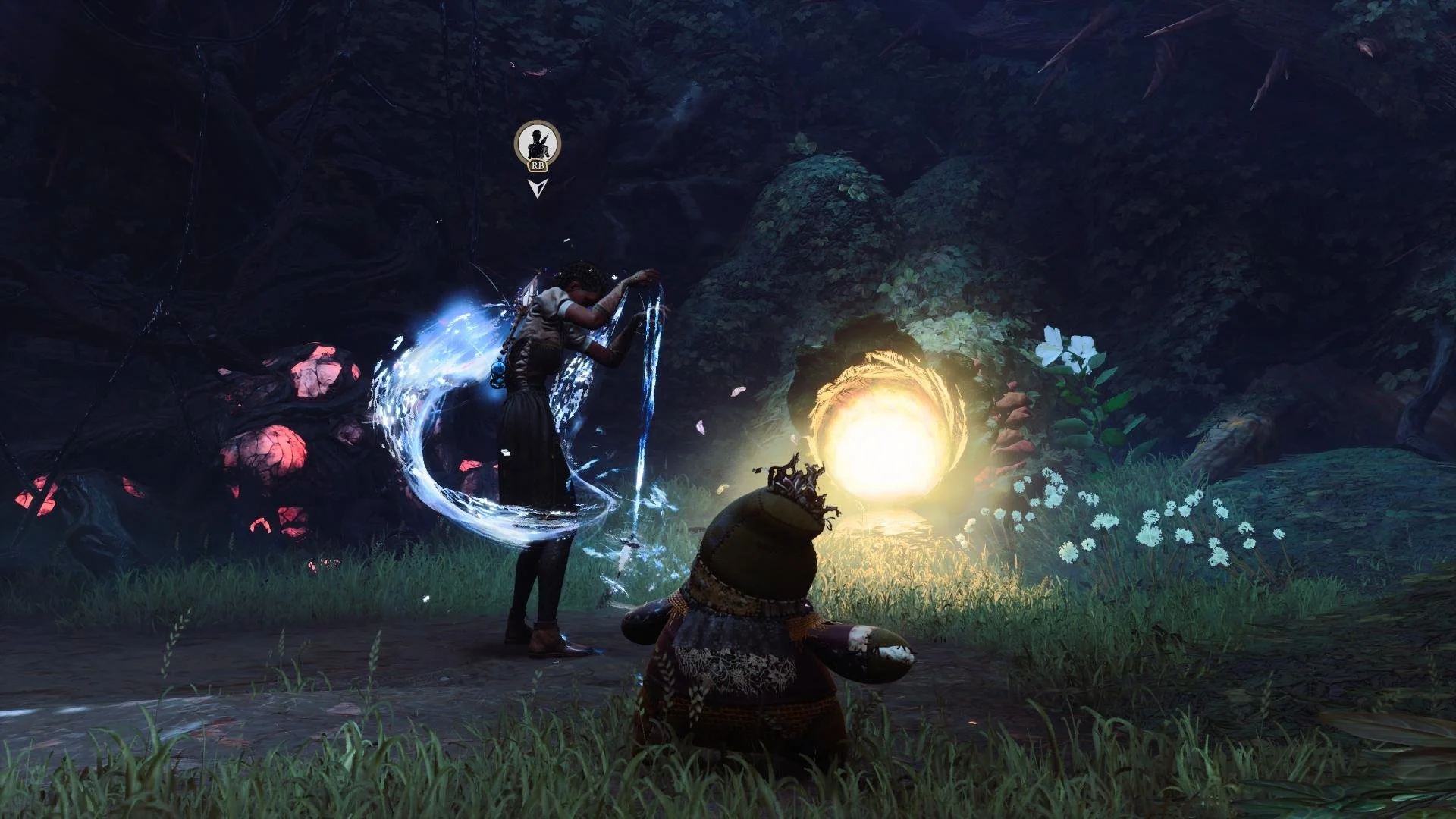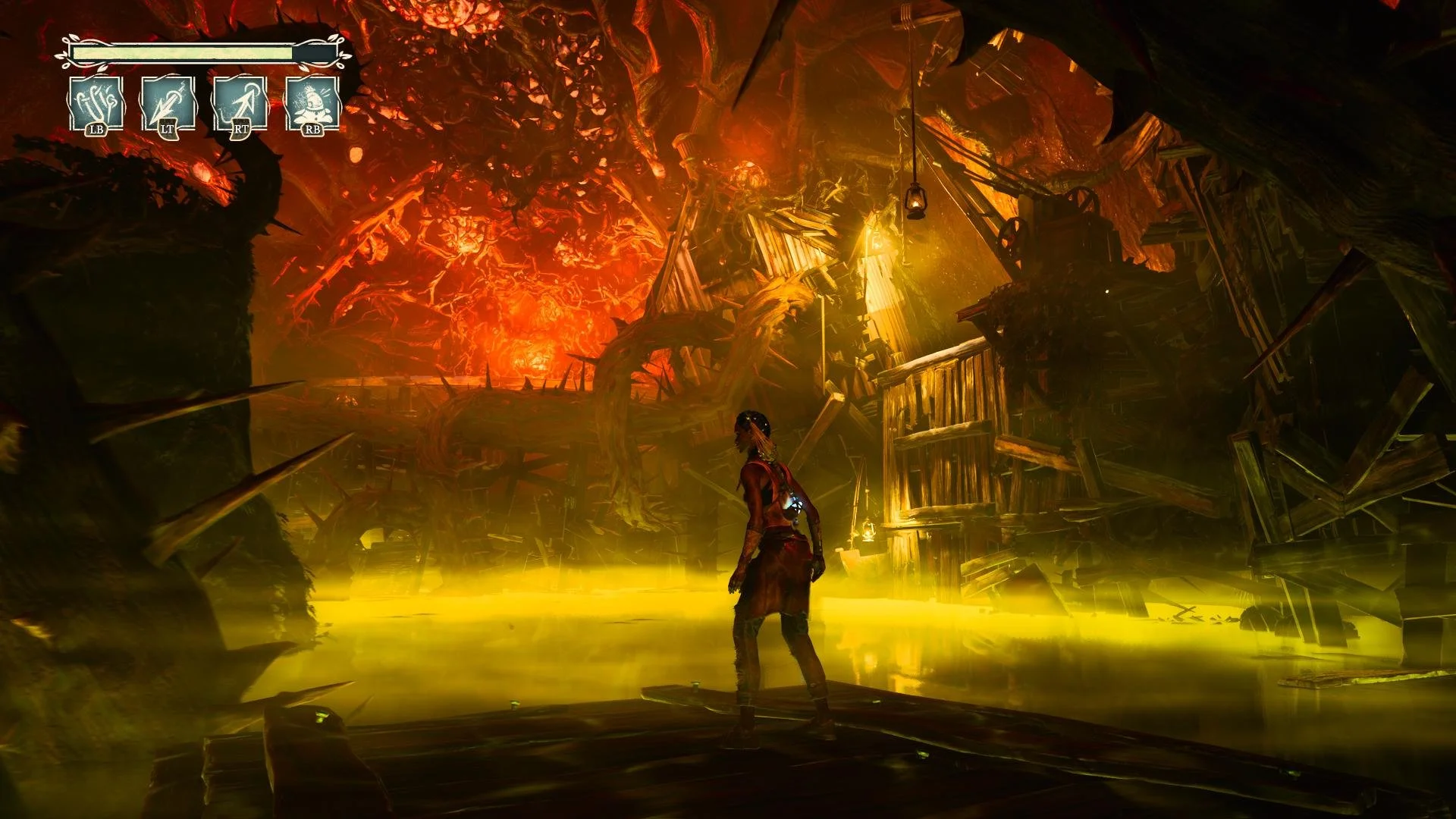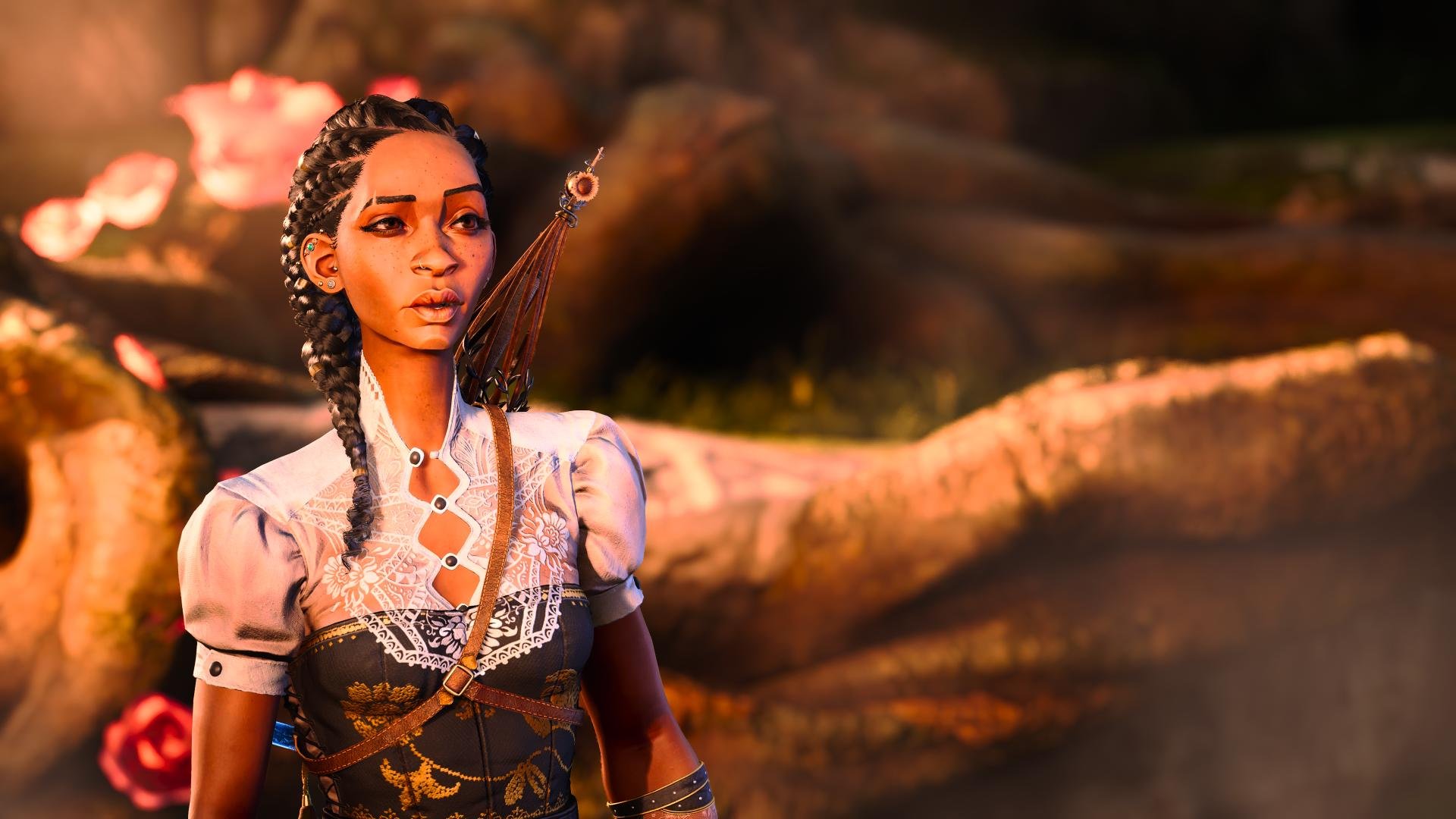Hainters gonna Haint.
Over a decade ago, Canadian-based Compulsion Games entertained with 2013’s Contrast, a puzzle platformer where you would reside within the shadows that were created due to your perspective. It was a rather ingenious adventure that certainly put the team on many people's radar. While 2018’s We Happy Few didn’t personally grab my attention, I was still eager to see what the team could do, given that they joined Xbox Studios that same year. And what was next was revealed at the 2023 Xbox Games Summer Showcase: an adventure game set in the deep South, appropriately titled South of Midnight.
South of Midnight is set in the stories of Cajun and other deep South folklore. As Hazel Flood is prepping for a hurricane, one that is set to wreak havoc in her small town, her mobile home is swept away, with her mother in it. Her journey to save her will cause Hazel to be bestowed powers, given that she is unknowingly a Weaver, a warrior of sorts, set to protect and heal those in need. Weavers heal those who suffer from trauma, and Hazel will learn and experience plenty of it as she aims to save her mama from an evil who is bathed in it.
The stories told here, the world-building to make you identify and care for its characters, is remarkably well crafted. That said, a lot of it has to do with the presentation around the music, the performances, and the aesthetic of the whole package. Adriyan Rae, as Hazel, is tremendous here, easily a strong candidate for many gaming awards this year. She is surrounded by a truly fantastic cast, which is both joined and directed by Ahmed Best. Yes, of Jar Jar Binks fame. Every voice is fine-tuned to serve that character and fit within the world crafted here. Walt Roberts is another stand out as the Catfish that acts as a guide, narrator, and transportation for the young Weaver.
South of Midnight does contain some very real moments of history. Not the moments themselves, but the culture around those moments. While the game attempts to dip into those controversial waters, it rarely commits to them. We see a Weaver from the past helping those escape, but never what they are running from. We see glimpses of segregation, racial tolerances, and more of how these people suffered. Some of this is found in notes you'll discover, with some commentary from Hazel, but ultimately, it's a surface level approach to addressing it without a full commitment to talk about it.
South of Midnight breaks down its gameplay into a few pillars: Exploration, Platforming, Combat, and Puzzle-solving, even if the latter is not as well realized or made far too simple to really reside in the genre. Spread out across 14 chapters, you’ll explore a gorgeous crop of the deep South and beyond, with plenty of swamps that take on all forms and colors and locations that defy expectation and yet feel fully rooted in the culture. This is one downright stunningly beautiful game that has some of the most rewarding uses of sunlight as it bathes your surroundings. And, while as colorful and bright as it can be, corruption gets its hooks into this land as it consumes and feeds on everything around it. From dangerous brambles and deep waters, Hazel will need to be cautious with every step.
As Hazel is coming to grips with some supernatural force keeping her alive and pushing her forward, she’ll encounter Haints, a monstrous form born of this corruption. While I absolutely love the designs of these creatures, there are sadly not too many of them, and their use is far too formulaic for my tastes. Combat is just as big of a part of this game as many of its core pillars, but one that people will likely latch onto first. After the initial gameplay trailer, the game was humorously given the nickname; Bayou-netta. Across the numerous comments, you can tell that people had grafted their own expectations onto this title, and combat plays a huge factor into if this game is for you. Its platforming certainly doesn’t reinvent the wheel, but combat could be seen as something that allows the title to be unique and to be part of the conversation. Sadly, it is a mix of things we’ve seen a hundred times already.
As you press on, Hazel will discover more of her powers and while that does open up the game's combat depth, you’ll see pretty much everything there is within the game’s first two or three hours. Sure, there is a skill tree to toughen up those powers and add more flair to certain aspects of them, but ultimately, you can attack, dodge, and even combine those into a surprise attack. You can hold down the attack button to place a lane in front of you, allowing that attack to harm anything in its path. That said, having the time to pull that off when you are surrounded is another story altogether. As enemies are defeated, you can then unravel them, giving you a small bit of health back in the process and trimming the time left on your cooldowns.
Hazel will also have several abilities to use in combat; Weave, Strand Push and Push, and unleashing the mighty Crouton, a small stitched-together doll that reminds me of Voodoo Vince, a title that isn’t too far off from some of the stories told here and is a personal favorite of Xbox boss, Phil Spencer.. Weave causes enemies to freeze in place, making them susceptible to damage, whereas Push and Pull give the appearance of Hazel having Jedi-like powers. As for the fifth and final ability, I’ll leave that one to discover on your own. Lastly, aside from those abilities, Hazel can also unleash a series of strands that attack enemies in a wide area by holding down the Y button.
Where combat feels basic is that you only have a single attack apart from freezing enemies, pushing or pulling them, or allowing Crouton to take over them as a temporary ally. While every game doesn’t need a parry, it would have opened up combat a bit more, as well as the inclusion of a heavy attack or slowing down time on a perfect dodge. While I did criticize the game for borrowing too much already, the absence of some of these tried and true mechanics does make combat feel like it is missing something to aid Hazel in at least defending herself. While you can dodge, that is all there is. Combat itself feels fine to pull off as the enemy variety is decent enough, but it is that the use of combat is heavily formulaic as you don’t encounter enemies while out and about; you only face them in the same types of combat areas that become all too familiar. This causes every single combat scenario to feel like the exact same dance.
I also want to point out the lock-on combat situation as it caused me a little frustration in its execution. South of Midnight isn’t the first game to do this, so some slack is certainly offered here. You can lock on to your foe, but also use the right stick to move that lock on to the next enemy. The problem here is moving the camera to get a better look at the battlefield with undoubtably shift the cursor around, especially as you will find yourself at the edge of the battlefield quite often, facing the wall. You can change the setting so that the swapping only occurs to those enemies in your sight, offering up some freedom with moving the camera around, but that doesn’t alleviate the issue at hand. Given that the enemies can blend into the background far too well at times, this causes this issue to persist further.
Combat, at its core, is a means to discover the truth behind the trauma you are investigating across each level. There will be an obstacle in your way that needs solving, and by engaging in three to four combat sessions that are indicated by looming strands flowing high into the air, these battles become the same song and dance each and every time, especially when the game stops delivering new enemy types to shake it up. Essentially, you’ll enter an area, take on these combat arenas, purge the corruption, learn about the trauma, bottle it up, and then escape the evil that has caught up with you and return said bottle to a tree at the end of the chase.
The latter results in a said chase sequence, one that should be intense and chaotic, but rarely feels it. Chase sequences often work rather well in games, but largely those that are 2D such as the Ori games, given you can see the path ahead of you as well as the evil that is behind you; it builds tension and excitement as you know exactly when said evil is nipping at your heels. With only being told there is a fog chasing you, it lacks the tension needed to make these encounters have weight. The sequences are a fine example of how good the platforming can be at times, but they lack the dread and intensity needed to give the chase urgency.
Like these sequences, South of Midnight is refreshingly linear. I say that due to the number of open-world games that feel stuffed for no reason as to add to their playtime. Here, the game is trimmed and free of excess bloat. While you can go off the beaten path to collect “Floofs” to work toward your skills, the game is very focused on pushing you through it, even having a guiding strand, ala Fable, to guide you to the correct path. This allows you to instantly know what is off the beaten path and what IS the path, making it easy to find more Floofs, or health pickups to extend your health meter, that and many of the game’s documents that enrich this gorgeous world by explaining a ton of details about its cast, and how particular character interact in this world.
Exploration and platforming then work hand in hand to explore and use Hazel’s gifts to traverse her surroundings. You’ll learn to double jump and glide through the air, even forming a parachute out of the strands woven into said air. These elements work well and while the climbing aspects of the platforming can be rough and rather bare bones at times, the elements of traversal are nonetheless solid. You’ll also weave past objects into existence, even if the objects themselves consist solely of wood platforms, tables, wagons, and boxes. Seeing the same tarped wagon over and over again didn’t really bother me too much, but the continued use of the same objects is still disappointingly minor. Nonetheless, I do wish you could have woven these objects while in the air as it would have added urgency to the chase sequences.
The last three methods of traversal come from the environment rather than from Hazel’s fingertips, at least sort of. Hazel can wall run, complete with moving up and down the wall with the right analog stick, fly via tunnels of air, and use grapple points to slingshot her way around. These sequences are best used during the chase sequences, but are welcome additions to a game that was almost showing its hand all too early. This also allows the level design to flourish in ways than just being locations connected by combat encounter arenas with not much else in between. While these abilities could have resulted in South of Midnight having a Metroidvania approach, it is nothing of the sort.
In the early hours of the game, you’ll have a series of prompts that act as tutorials for Hazel’s abilities. While I’m not sure we needed the platforming climbing tutorial, as the white paint is everywhere, many of them have several pages of context that feel like they are overexplaining their information too much. That aside, the game likes to take control away from you often, panning the camera or focusing on something as a way to get your attention. I actually fell off a platform as I kept running while this happened in one instance. It’s a shame there wasn’t a button prompt to manually focus where they want you to look instead of taking control of the camera away from you. It’s an annoyance to some, but I can see many being extremely frustrated by it.
Most of this occurs in the form of introducing you to several of the game’s environmental puzzles. That said, as I mentioned before, it’s hard to even call them puzzles. You’ll approach a locked gate that needs power, but simply finding the generator is the fix. Sometimes, you’ll need to take control of Crouton, or throw him to where you’ll need him to go, and trigger the solution that way. Otherwise, you’ll blast the same branches away to find more Floofs, or notice the same planks that need clearing and instantly know what to do. Contrast was a game with such brilliance behind it, and I don’t see much of that here.
From an outstanding score to several original songs, the music across this roughly 12 hour game is outstanding. There is a track that plays as you climb a massive tree that I could see being nominated for Best Song at the game awards, it's that good. The music, like the chapter breaks in Alan Wake 2, has their songs explain aspects of the story. From the lyrics to the music itself, every song and score sells the adventure that Hazel has embarked on extremely well; it's remarkably powerful and fitting to the culture with its use of prohibition-era Jazz, guitar, and blues.
When South of Midnight offered its first glance at gameplay, it showed a stop motion effect where the characters and enemies would run at approximately 15fps, while the gameplay ran at 60fps, even across Series S. This creates an effect similar to the likes of Into the Spiderverse where Miles would operate at a different framerate than the world and characters around him. This effect is remarkably cool, and while you can turn it off in the settings, it doesn't affect the cutscenes, which run at a locked 30.
Visually, South of Midnight is astonishingly superb. The character designs in Hazel and the Catfish, and even the massive island-sized Crocodile, are incredible. The environments fare just as well with some wonderful settings filled with both color and muted tones, depending on the location. Regardless, the character work to bring Hazel to life is stunning, and causes to Hazel to join my list of some of my favorite protagonists ever.
South of Midnight is a game of high highs and soft lows, largely contributing to some weak combat, that while often fun, is a tad too formulaic. While I certainly have my issues across several fronts offered in the game, the story, its rich characters and backstories are the star of the show and shine incredibly bright. Overall, when South of Midnight is firing on all cylinders, it's a truly remarkable story with engaging characters, a wonderful setting, and a music score that constantly shines.
South of Midnight features a great deal of strong accessibility features that I was rather impressed by. You can change all colors that represent things like health, or magic, or the color of your converted ally. You can adjust the guiding strand so that it is more present or absent or replaced by an audio cue. And, should combat or the chase sequences be beyond your skill level, you can opt to skip them, should you see fit. Other settings see assists to gliding or sprinting, offering you help when needed. It’s not the most robust set of accessibility settings, but still provides enough for any level of skill to enjoy the game.
Developer - Compulsion Games.
Publisher - Xbox Games Studios. Released - April 3rd, 2025 (Premium Edition), April 8th (Regular Edition). Available On - Xbox Series X/S, PC. Rated - (M) - Blood, Strong Language, Violence. Platform Reviewed - Xbox Series X. Review Access - A review code was provided by the publisher for the purpose of this review.




















Jeff is the original founder of Analog Stick Gaming. His favorite games include The Witcher III, the Mass Effect Trilogy, Hi-Fi Rush, Stellar Blade, Hellbade: Senua’s Sacrifice, and the Legend of Heroes series, especially Trails of Cold Steel III & IV.